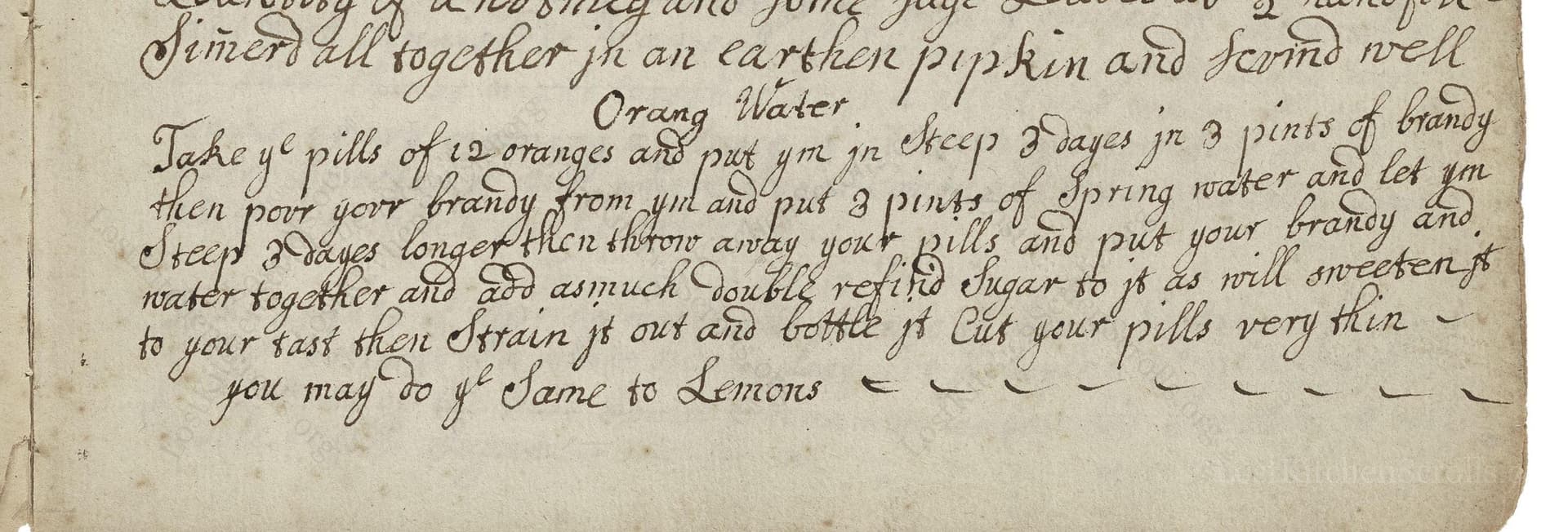Orang Water
From the treasured pages of Cookbook of Mary Cruso and Timothy Cruso
Written by Mary Cruso

Orang Water
"Take ye pills of 12 oranges and put ym in steep 3 dayes in 3 pints of brandy then pour your brandy from ym and put a pint of Spring water and let ym steep 3 dayes longer then throw away your pills and put your brandy and water together and add asmuch Double refind Sugar to it as will sweeten it to your tast then Strain it out and bottle it Cut your pills very thin - you may do ye Same to Lemons - - - -"
Note on the Original Text
The original recipe is written in early modern English with period spelling ('ye' for 'the', 'ym' for 'them', 'dayes' for 'days', 'pills' for 'peels'). Instructions are both direct and conversational, reflecting a tradition of recipes as shared household knowledge rather than exact formulas. Quantities are given in familiar household measures (pints), and there is an assumption of intuitive adjustment—especially for sweetness—rather than strict precision. The text omits details that would have been commonsense to contemporary readers, such as the method of peeling, or precise sugar amounts.

Title
Cookbook of Mary Cruso and Timothy Cruso (1689)
You can also click the book image above to peruse the original tome
Writer
Mary Cruso
Era
1689
Publisher
Unknown
Background
Step into the flavorful world of 17th-century cuisine with Mary Cruso’s delightful collection, where time-honored recipes and inventive cookery tips offer a peek at the tastes and talents of yesteryear’s domestic kitchens.
Kindly made available by
Folger Shakespeare Library
This recipe originates from Mary Cruso, dated 1689, a period when homemade cordials, liqueurs, and medicinal waters were quite the fashion among genteel households. These orange waters weren't just for pleasure—they served both as drinks and as remedies, believed to settle the stomach and uplift the spirits. The use of both orange and lemon peels reflects the period's fascination with the bright, aromatic qualities of exotic citrus, which had only recently become widely available in England. The careful infusion and sweetening showcase early modern England's love for elaborate, flavorful infusions.

In the late 17th century, cooks would have used a small paring knife to carefully peel citrus fruit, and a large glass or glazed stoneware jar for maceration. Liquids were strained through clean linen or muslin cloth, and the final product was decanted into glass bottles sealed with cork. Precise measurement was less critical than today; cooks would estimate volumes with pitchers and use judgment for sugar.
Prep Time
20 mins
Cook Time
0 mins
Servings
24
We've done our best to adapt this historical recipe for modern kitchens, but some details may still need refinement. We warmly welcome feedback from fellow cooks and culinary historians — your insights support the entire community!
Ingredients
- 12 oranges (peels only, thinly sliced)
- 1.5 quarts brandy
- 1 pint spring water
- Caster sugar (double refined sugar), to taste (around 7–14 oz, or adjust to preference)
Instructions
- Begin by peeling 12 oranges, slicing the peels very thinly (avoiding as much white pith as possible).
- Place the thinly sliced peels in a jar and add 1.5 quarts of brandy.
- Seal and let it steep for 3 days in a cool, dark place.
- After 3 days, strain off the brandy and reserve it.
- Add 1 pint of spring water to the orange peels in the jar and steep for another 3 days.
- Discard the peels, then mix the infused brandy and the orange-flavored water together.
- Sweeten the mixture to taste with fine white sugar (double refined sugar in the past—use caster sugar today), stirring until dissolved.
- Strain the liquid through a fine muslin or coffee filter and bottle.
- This process can also be used with lemons instead of oranges.
Estimated Calories
150 per serving
Cooking Estimates
This recipe takes a while because you need to let both the orange peels and water steep for 3 days each. Actual active prep only takes about 20 minutes to peel and slice the oranges and set things up. Each serving is about 80 ml (just under 3 oz), and this drink is sweet and strong, with about 150 calories per serving. The full recipe makes about 24 servings.
As noted above, we have made our best effort to translate and adapt this historical recipe for modern kitchens, taking into account ingredients nowadays, cooking techniques, measurements, and so on. However, historical recipes often contain assumptions that require interpretation.
We'd love for anyone to help improve these adaptations. Community contributions are highly welcome. If you have suggestions, corrections, or cooking tips based on your experience with this recipe, please share them below.
Join the Discussion
Rate This Recipe
Dietary Preference
Main Ingredients
Culinary Technique

Den Bockfisch In Einer Fleisch Suppen Zu Kochen
This recipe hails from a German manuscript cookbook compiled in 1696, a time whe...

Die Grieß Nudlen Zumachen
This recipe comes from a rather mysterious manuscript cookbook, penned anonymous...

Ein Boudain
This recipe comes from an anonymous German-language manuscript cookbook from 169...

Ein Gesaltzen Citroni
This recipe, dating from 1696, comes from an extensive anonymous German cookbook...
Browse our complete collection of time-honored recipes



